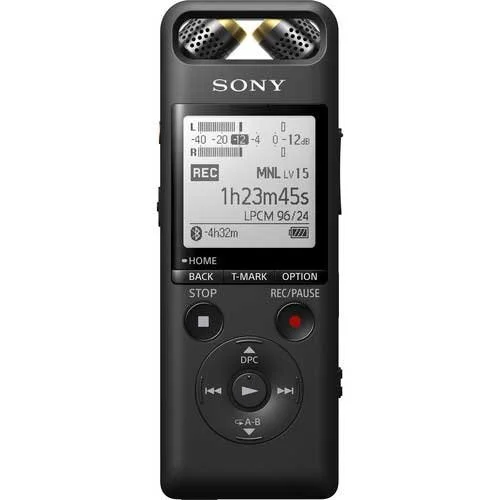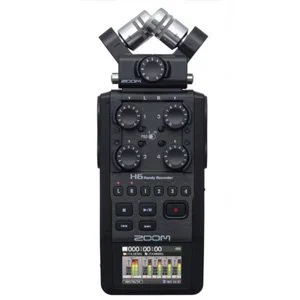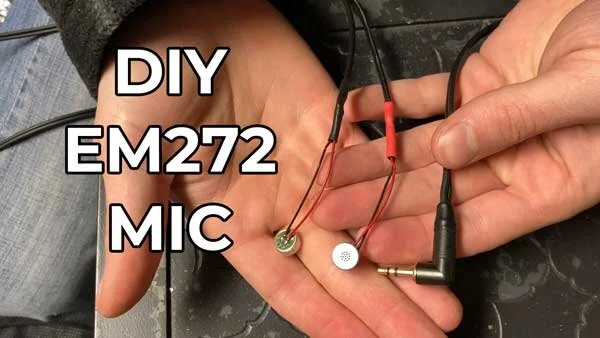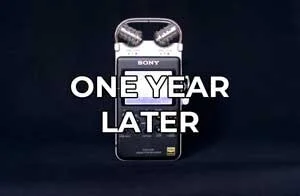Best Handheld Field Recorder (First-Time Buyers Guide)
Find out what makes a good field recorder and the top models in this article!
In order to start field recording, you need a field recorder. However, all of the numbers, specifications, and technical jargon can make purchasing your first field recorder confusing and overwhelming; trust me, I’ve been there.
With so many entry-level options on the market, it can be difficult for the beginner to navigate the sea of choices and make a good selection.
This is exactly what happened to me. Because I didn’t know what to look for, my first field recorder was a total dud.
To prevent this from happening to you, I’ve created this resource. In this article, I give my professional advice and opinion on the best field recorders on the market, and teach you about all the important details that make a great field recorder.
If you want to skip the details and learn what field recorders are the best, they’re ranked by ascending price below.
To learn about important field recorder features, click here.
Links in this article are affiliate including Amazon Associates. This is not a sponsored post and all opinions are my own.
The Best Handheld Field Recorders Ranked By Price:
After researching every field recorder on the market and having hands-on experience with 6 of them, these are the best portable field recorders available.
Click “learn more” to read more detailed information about each recommended field recorder.
1. Zoom H1n
The Zoom H1n is one of the best handheld field recorders for beginners thanks to its low-noise preamps and budget-friendly price.
It is very small, has a knob for gain adjustments, and provides plug-in-power for a 3.5mm external microphone.
Its biggest downside is its plastic construction and lack of an internal memory.
If you don’t mind the color, BH Photo has an exclusive, gray-colored edition that is cheaper than the black model.
2. Olympus LS-P1
Inefficiently marketed as a voice recorder, the Olympus LS-P1 is actually a better field recorder than the Zoom H1n.
For the same price or cheaper (depending where you shop), the LS-P1 is quieter than the H1n and features a solid, aluminum body and has a 4GB internal memory.
However, the menu system is inefficient and accessing low-cut filters and limiter settings takes a few clicks. Additionally, it is less intuitive than the H1n and reading the manual is recommended for getting the most out of the LS-P1.
In my opinion, this is the best, low-budget field recorder. It’s more awkward to use than the Zoom H1n, but its aluminum body and lower noise make it worth it.
Olympus doesn’t manufacture the LS-P1 anymore so stock is limited.
3. Sony PCM-A10
The Sony PCM-A10 is slightly more quiet than the Olympus LS-P1 and features swiveling microphones that can be arranged in 90° XY or 120° wide stereo positions.
The PCM-A10 will fit in your pocket and has a respectable, 16 GB internal memory.
The rechargeable, internal battery cannot be removed, but the A10 can easily be powered via an external power supply thanks to its built-in USB port.
4. Zoom H5
For about $50 more, the Zoom H5 offers a big improvement in self-noise and versatility over the Sony PCM A-10.
The Zoom H5 has 2 XLR inputs for phantom powering condenser microphones. Each input has its own gain adjustment knob for fast and easy adjustments. However, the XLR inputs are non-locking
Additionally, the onboard mics are detachable and interchangeable with other pickup patterns. Currently, Zoom offers 6 mic capsule options including shotgun and mid-side options.
5. Zoom H6
The Zoom H6 is basically the same as the Zoom H5 but has two additional XLR inputs for a total of four.
The Zoom H6 also features a full color, LCD display that is significantly larger than the screen on the H5.
The Zoom H6 is a great entry-level field recorder for location sound recordists who need multiple XLR inputs.
6. Sony PCM-D100
The Sony PCM-D100 is the king of all handheld field recorders. It has the quietest preamps of any model and comes with some great accessories, but it’s not cheap and doesn’t support XLR microphones.
This is my primary recorder and it is awesome for capturing quiet nature sounds.
My favorite features of the D100 include the swiveling microphone capsules, the aluminum body, its great battery life, and of course, its low self-noise. I also love the included case and wind protection. It also comes with a remote control and receiver, but I haven’t found a use for them.
I don’t like that the backlight brightness isn’t adjustable and the S/N 100dB mode is a gimmick.
UPDATE: The Sony PCM D100 has been discontinued and is only available on used marketplaces. Click below to check availability.
Important Field Recorder Features
Field recorders are often described with lots of numbers and weird terminology, but what do they all mean? This section is a crash-course on the most important field recorder features and specifications. Jump to a specific section by clicking below.
• Self-Noise • XLR + Phantom Power • Plastic vs. Metal • Accessories • Internal Memory
Self-Noise
Self-noise is arguably the most important factor to consider when choosing a field recorder because it directly impacts the overall sound quality. So what is it?
Self-noise is the noise produced by electrons moving in a circuit. It sounds like a white-noise hissing sound. The best way to hear it is by recording a dead-quiet room at maximum gain.
Depending on the components used in construction like tubes, transistors, resistors, and the layout of the PCB, the self-noise of a device can be minimized.
The problem with self-noise is that too much of it can ruin a recording. When using a field recorder with high self-noise, the hissing sound of the recorder can overpower your subject. At best, this can be distracting, and at worst, unbearable.
Self-noise is most commonly measured as Equivalent Input Noise (EIN). EIN is the best method for comparing self-noise levels because it removes gain from the equation and makes for apples-to apples comparisons.
So how much self-noise is too much? Well, it depends on what you’re recording. If you’re recording loud sounds, your subject will easily overpower the noise from the recorder. Self-noise usually becomes a problem when attempting to record very quiet sounds.
Use the chart below to determine what an acceptable EIN for your device is.
| EIN (dBu) | Rating | Description |
|---|---|---|
| -130 | Ultra-Quiet | Noise undetectable in anything but the most critical recording conditions. |
| -126 | Very Good | Very slight noise discernible when recording quiet sounds. |
| -119 | Good | Good enough for most purposes. Noise noticeable in quieter recordings. |
| -110 | Fair | Noise obvious when recording anything below speaking level. |
| -100 | Poor | Not recommended. |
XLR + Phantom Power
If you intend on using external microphones with your field recorder that require XLR connections and/or phantom power, it’s important to confirm that your field recorder supports them.
This will really narrow-down your options since relatively few handheld recorders support XLR mics.
Opting for a field recorder that supports XLR microphones can also be a good choice if you plan to upgrade to condenser mics down the road. This way, when you do upgrade, you won’t have to buy a new field recorder with XLR support. You can continue to grow, learn, and experiment with the same recorder.
One note on phantom power. Phantom power is the voltage necessary to power a condenser microphone. Using a field recorder to provide phantom power to a microphone will greatly reduce battery life.
Plastic vs. Metal Construction
Normally when it comes to build quality, metal components are always better than plastic. However, in the audio world, there are tradeoffs for both that are worth considering.
A field recorder made with plastic is better for handheld recordings. Plastic helps to deaden the vibrations created by subtle movements of your hand while holding the recorder. It’s not perfect, but with a firm grip, you can get great sounding recordings handheld.
Trying to do the same with a metal bodied field recorder is almost impossible. Every slight movement of your hand, even the creaking of your joints, is transferred to the microphones. Using a tripod or shockmount is a must with a metal field recorder.
On the flip side, a plastic bodied field recorder is not as durable as an aluminum field recorder. As a nature recordist, I prefer the aluminum body for its extra durability in the field. I’m not particularly rough on gear, but I like the insurance factor of a more robustly built recorder.
Plastic:
+ less handling noise
- less durable
Metal:
+ more durable
- more handling noise
Related Article: Best Tripod for Field Recording
Accessories
If you are between two field recorders with similar specifications, the included accessories could be the tie-breaker. Some field recorders comes with lots of extras and some come with none. Possible accessories include: wind protection, recorder case, AC adapter, remote control, and receiver.
Wind Protection
If you are planning on recording outdoors, you will need something to protect your microphones from the wind. Field recorder microphones are incredibly sensitive to wind (moving air). Even just a gentle breeze can distort your audio and ruin your recording. To prevent this from happening, you’ll need some wind protection.
Wind protection for handheld recorders typically come in 2 styles: foam and furry. Furry wind protection, commonly called “deadcats”, are much better at blocking wind than their foam counterparts.
Unfortunately, it is rare for a field recorder to include either form of wind protection and this accessory will have to be purchased separately.
Recorder Case
Having a case for your recorder is a really nice extra, especially if you do a lot of traveling with your equipment.
In my opinion, the best cases are soft, padded, and have little pockets for stowing extra memory cards, short audio cables, or even business cards.
Lower quality cases tend to be hard plastic shells that simply snap open and closed. No extra features to speak of, but will protect your recorder from bumps and scratches while in your sound bag.
AC Adapter
An AC Adapter plugs into a wall outlet and powers your field recorder without the need for batteries. They are useful when recording indoors for extended periods of time. Instead of using up a bunch of batteries, simply power your device with the AC adapter.
Remote/Receiver
Some field recorders come with a remote control and a receiver. The receiver plugs into the field recorder and receives signals sent from the remote. Hands-free, and from a distance, you can use the remote to start/pause/resume a recording, mark a track, and control playback (start/stop/fast forward/rewind/skip track).
My Sony PCM-D100 comes with this accessory but I have not found a use for it. If this feature is important to you, find out if it’s included.
Internal Memory
If your field recorder does not have an internal memory, and you forget your SD card, you will not be able to record!
This has happened to me before and it is the most frustrating thing you can do to yourself.
While forgetting a memory card at home falls on the human, a field recorder with an internal memory can be a lifesaver.
Related Article: Does SD Speed Matter For Audio?
The Best Handheld Field Recorders (detailed)
Zoom H1n
At -112 dBu, the Zoom H1n falls between a “fair” and “good” self-noise rating. At this level, it is capable of recording relatively quiet sounds down to 40dB (the loudness of singing birds).
When recording sounds louder than this, the noise of the H1n will be imperceptible.
The menu system is great. Commonly accessed settings like recording format, low-cut filter, and limiter can all be accessed with one click; no menu-diving necessary.
In my review of the H1n, I found it less sensitive to lower frequencies than other field recorders, but still found the low-cut filter useful when outdoors.
The H1n takes 2 AAA batteries with okay results. Battery life was 9hr 13min @ 96kHz/24bit.
Without SDXC memory card support, the maximum capacity card for the H1n is 32GB.
Overall, the H1n is extremely easy to use and offers decent noise performance, making it one of the most popular handheld field recorders for beginners.
| Self-Noise (EIN) | XLR Support | Material | Internal Memory | SD Card Support | Battery | Accessories |
|---|---|---|---|---|---|---|
| -112 dBu | No | Plastic | No | microSD, microSDHC | 2 AAA | None |
Olympus LS-P1
The Olympus LS-P1 has a self-noise of -114dBu, quieter than the H1n by 2dBu.
The aluminum body of the LS-P1 is very durable and will hold up better after extended field use.
It has a 4GB internal memory so if you forget your micro SD card, you will still be able to record 2 hours of audio at 96kHz/24bit.
The LS-P1 supports microSDHC cards with a maximum capacity of 32GB.
The low-cut filter only has two positions: 300Hz and 100Hz. These options are somewhat limiting. It may be best to leave the low-cut filter “off” and add a custom one during post-production.
I wish there was a knob for adjusting gain. Instead, the ⏭ or ⏮ buttons are used during recording or in standby mode to change the gain from 0-30.
The LS-P1 comes with a rechargeable AAA battery and claims nearly triple the battery life of the H1n. The built in USB port can easily attach to a portable power supply to increase the battery life even more.
| Self-Noise (EIN) | XLR Support | Material | Internal Memory | SD Card Support | Battery | Accessories |
|---|---|---|---|---|---|---|
| -114 dBu | No | Aluminum | 4GB | microSDHC | 1 AAA | Rechargeable AAA |
Sony PCM-A10
The Sony PCM-A10 has a self-noise of -116dBu. It is slightly quieter than the LS-P1 and considerably quieter than the H1n.
Released in 2019, the A10 has all the standard field recorder features (limiter, low-cut filter, peak indicator lights) plus a few upgrades.
The capsules can be arranged in 90° XY or 120° wide stereo positions and the A10 also supports Bluetooth connections.
When controlling the A10 wirelessly with the REC Remote app from Sony, you can monitor your recording levels, adjust the gain, add track marks, and change your recording settings. Unfortunately, you cannot monitor the sound of your recording live via Bluetooth.
The PCM-A10 is made of plastic and comes with a soft pouch and a foam windscreen.
The built-in, rechargeable battery has an impressive battery life of 15 hours when recording at 96kHz/24bit. Like the LS-P1, it also has a retractable USB port that can easily attach to a power bank for even longer battery life.
I really like its large, 16GB internal memory and support for extended-capacity, microSDXC cards.
| Self-Noise (EIN) | XLR Support | Material | Internal Memory | SD Card Support | Battery | Accessories |
|---|---|---|---|---|---|---|
| -116 dBu | No | Plastic | 16GB | microSDHC, microSDXC | Internal | Foam Windscreen, Soft Pouch |
Zoom H5
At -121dBu self-noise, the Zoom H5 is a big improvement over any of the previously mentioned field recorders in terms of self-noise.
The two XLR inputs have their own gain knobs and can supply +12v, +24v, or +48v phantom power for optimal use with any condenser microphone.
The low-cut filter has 10 different settings between 80-237Hz! The limiter and compressor also have extended settings with 3 options for each.
For even more customization, a unique low-cut, limiter, and compressor settings can be applied to each input independently (L/R mic capsules, XLR1, XLR2).
Although made of plastic, the H5 has a rubberized finish that gives it a premium feel. The housings for the onboard mics are made of metal.
A joystick is used to control the menu. It works great for scrolling up and down, but pushing it in to make a selection can be frustrating because it only works if pushed in perfectly straight (not easy to do every time).
| Self-Noise (EIN) | XLR Support | Material | Internal Memory | SD Card Support | Battery | Accessories |
|---|---|---|---|---|---|---|
| -121 dBu | Yes (2) | Plastic | No | SDHC | 2 AA | Foam Windscreen, Hard Plastic Case |
Zoom H6
Also with a self noise of -121dBu is the Zoom H6.
The H6 is an upgrade over the H5 with support for larger memory cards, two additional XLR inputs and a large, full color LCD screen.
The four XLR inputs have their own gain knobs and can supply +12v, +24v, or +48v phantom power for optimal use with any condenser microphone.
The low-cut filter has 10 different settings between 80-237Hz! The limiter and compressor also have extended settings with 3 options for each.
For even more customization, a unique low-cut, limiter, and compressor settings can be applied to each input independently (L/R mic capsules, XLR1, XLR2).
Although made of plastic, the H6 has a rubberized finish that gives it a premium feel. The housings for the onboard mics are made of metal.
A joystick is used to control the menu. It works great for scrolling up and down, but pushing it in to make a selection can be frustrating because it only works if pushed in perfectly straight (not easy to do every time).
| Self-Noise (EIN) | XLR Support | Material | Internal Memory | SD Card Support | Battery | Accessories |
|---|---|---|---|---|---|---|
| -121 dBu | Yes (4) | Plastic | No | SDHC, SDXC | Internal, 2 AA | Foam Windscreen, Hard Plastic Case |
Sony PCM-D100
At -127dBu, the Sony PCM-D100 is the quietest handheld field recorder ever made.
The D100 includes all the accessories you’d expect at this price-point: a padded case with multiple zippers and pockets, a furry windshield, a remote, and a receiver.
The body is ruggedly built from aluminum and the button layout makes for easy, one-handed operation.
I really like the individual knobs used to control gain and headphone volume.
For memory, the D100 has an impressive, 32GB internal memory and supports extended-capacity SDXC memory cards.
The Sony PCM-D100 has an advanced limiter that takes advantage of the dual analog-to-digital converters inside the D100.
When the limiter is “on”, one signal is attenuated by 12dB and fed into a recording buffer. If the main signal path clips, the D100 seamlessly crossfades to the attenuated, undistorted signal. Sony calls this “an artifact-free method of limiting.”
If I could change anything on my D100, I would make the backlight brightness adjustable.
For even more information, ready my 1-year review here.
| Self-Noise (EIN) | XLR Support | Material | Internal Memory | SD Card Support | Battery | Accessories |
|---|---|---|---|---|---|---|
| -127 dBu | No | Aluminum | 32GB | SDHC, SDXC | 4 AA | Furry Windscreen, Padded Case, Remote, Receiver |
Final Thoughts
Getting started in sound as a new hobby or career can be challenging. I hope that this article has shed some light on handheld field recorders and how to pick the best one for yourself.
If you have any questions, please do not hesitate to contact me, I am always happy to help!
If you enjoyed this post and want to support this website, please consider using the purchase links on this page. They are affiliate and I will receive a small commission. Thank you for supporting my dream of becoming a full-time field recordist!
Support Acoustic Nature
If you enjoyed this post and would like to help support Acoustic Nature, please consider "buying me a coffee" or becoming a Patreon with the buttons below.
As a thank you for your support, Patreon supporters receive a copy of Field Recording For Beginners, exclusive access to the full Behind The Sounds video series, nature sound library downloads, and more.
If you are unable to support the site financially, please share this post with others, or leave a comment below letting me know you enjoyed this post! Both are free and help the website grow. Thank you ♫
Thanks for reading,
-Jared





















